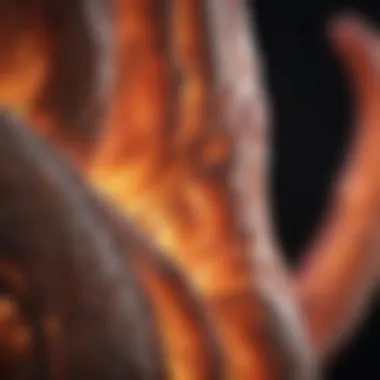Innovations in Burn Wound Healing: A Scientific Overview


Intro
Burn wounds present a significant challenge in medical practice, not only due to their physical impacts but also their psychosocial implications. Healing from such injuries is a complex process influenced by numerous factors, ranging from the type and severity of the burn to the patient's overall health and access to appropriate care. This article engages with the intricate dynamics of burn wound healing, aiming to shed light on current methodologies and innovations that enhance recovery outcomes.
Understanding the stages of burn wound healing is crucial. Each stage—hemostasis, inflammation, proliferation, and remodeling—offers insights into the biological mechanisms at work. Moreover, timely intervention can significantly affect recovery, which underscores the importance of advanced treatment techniques and care protocols. As research evolves, so too do the approaches to healing burn wounds, integrating fresh perspectives from various scientific domains.
In this exploration, we will delve into the latest advancements in burn treatment methodologies, critically examining both the traditional practices and cutting-edge innovations that are reshaping approaches to burn care. Special attention will be given to interdisciplinary connections that foster improved healing outcomes, further enriching the understanding of burn wound management.
Preamble to Burn Wounds
Burn wounds represent a significant challenge in the field of healthcare, both in terms of immediate medical care and long-term recovery. The understanding of burn injuries encompasses various essential components including their classification, causes, and the risk factors that contribute to their occurrence.
Burn wounds can lead to serious complications, affecting not just the skin but also deeper tissues and the body’s overall well-being. Therefore, it is crucial to explore the importance of burn wound management rigorously. This exploration not only highlights the complexities of healing but also the vital need for timely and effective treatment strategies.
Definition and Classification of Burn Wounds
Burn wounds are classified based on their depth and extent of damage. The commonly recognized categories are:
- First-degree burns: Affect only the outer layer of skin, causing redness and minor pain. A typical example is a mild sunburn.
- Second-degree burns: Involve deeper layers, leading to blisters and more significant pain. These can be further divided into superficial and deep partial-thickness burns.
- Third-degree burns: Extend through the skin and affect underlying tissues, often resulting in a waxy, white appearance and a loss of sensation in the affected area due to nerve damage.
- Fourth-degree burns: The most severe type, penetrating through the skin and into muscles and bones. This category can lead to life-threatening consequences.
Each classification defines the severity of the burn and directly influences treatment decisions. This classification not only assists healthcare providers but also helps patients understand the nature of their injuries.
Causes and Risk Factors for Burn Injuries
Burn injuries can arise from various sources. Understanding these causes is paramount in both prevention and management. The primary causes include:
- Thermal burns: Result from contact with hot objects, flames, or steam. These are perhaps the most common type.
- Chemical burns: Arise from contact with corrosive substances such as acids or alkalis. They can continue to damage tissues over time if not promptly treated.
- Electrical burns: Result from electric shock, potentially causing internal damage even when the external injury appears minor.
- Radiation burns: Often caused by sun exposure or radiation therapy, leading to skin damage.
Certain risk factors increase the likelihood of suffering a burn. These include age, work environment, presence of safety regulations, and personal behavior.
Understanding these essential definitions and classifications provides a solid framework for comprehending the complexities involved in burn wound healing. Recognizing the causes and risk factors associated with these injuries can significantly enhance prevention efforts and improve outcomes in burn care.
Pathophysiology of Burn Wound Healing
Understanding the pathophysiology of burn wound healing is critical for effective management and recovery of patients. This complex process involves intricate biological mechanisms that are essential for restoring skin integrity and function after an injury. By comprehensively examining the stages of wound healing, the inflammatory response, and tissue regeneration, healthcare professionals can tailor treatments to optimize healing outcomes.
Stages of Wound Healing
The wound healing process can be divided into four key stages:
- Hemostasis: This initial stage occurs immediately after the injury. Blood vessels constrict to reduce blood loss, and platelets aggregate to form a clot. This lays the groundwork for a matrix that will support future healing.
- Inflammation: In this stage, immune cells, particularly neutrophils and macrophages, flood the wound site to manage infection and debris. This response is crucial as it not only clears pathogens but also releases signaling molecules that promote healing.
- Proliferation: This phase involves the formation of new tissue. Fibroblasts play a vital role by synthesizing collagen, which provides strength and structure to the wound. Endothelial cells also contribute by forming new blood vessels, enhancing nutrient delivery.
- Maturation and Remodeling: During this final stage, the newly formed tissue undergoes changes to improve strength and flexibility. Collagen fibers reorganize, and the blood supply gradually decreases.
Recognizing these stages allows practitioners to assess the healing process effectively. In situations where healing is delayed, interventions can be implemented to address specific concerns.
Inflammatory Response and Its Role


The inflammatory response is a double-edged sword in burn wound healing. While it is essential for combating infection and initiating repair, excessive inflammation can hinder recovery. Key components of the inflammatory response include:
- Cytokines: These signaling molecules are released by immune cells and play a role in communication between cells. They help regulate the healing response, but imbalances can lead to chronic inflammation.
- Cellular Recruitment: The influx of cells to the wound area maintains a defense against pathogens, but an overload can contribute to tissue damage and prolong healing times.
Evaluating the inflammatory response is crucial. Monitoring markers associated with inflammation can provide insights into whether the healing process is progressing well or needs intervention.
Tissue Regeneration and Repair Processes
Tissue regeneration is a vital aspect of burn wound healing. It involves not only replacing lost cells but also restoring normal tissue architecture and function. Important factors in this process include:
- Stem Cells: These cells can differentiate into various cell types, aiding in regenerating damaged tissues. In burn wounds, stem cells present in the skin's basal layer can migrate to the injury site to facilitate healing.
- Extracellular Matrix (ECM): The ECM is a complex network of proteins that provides structural support to tissues. Understanding its composition and function helps researchers develop treatments that enhance tissue repair.
- Growth Factors: These proteins stimulate cell growth, differentiation, and healing. Drugs targeting growth factors are being researched as potential therapies for improving skin regeneration in burn wounds.
Insummary, the pathophysiology of burn wound healing is fundamental in formulating innovative treatment strategies. By understanding the distinct stages, the inflammatory response, and regeneration processes, medical professionals can enhance patient outcomes and advance the field of burn care.
"Understanding the intricacies of wound healing directly impacts clinical practices and patient recovery."
For further reading on burn healing and treatment methodologies, visit Wikipedia.
Learn about the biological aspects of burn wounds on Britannica.
Factors Influencing Burn Wound Healing
Understanding the factors that influence burn wound healing is essential for improving patient outcomes. This section delves into the diverse elements that can affect the recovery process of burn injuries. Various aspects such as individual characteristics, external conditions, and the presence of infection have a significant impact on how well and how quickly a burn wound heals. The implications of these factors guide clinical practices and treatment strategies, making it a vital area of study in burn care.
Individual Patient Factors
Individual patient factors encompass a range of elements, including age, genetics, and overall health, that can greatly influence the healing of burn wounds. For example, younger patients typically exhibit more robust healing responses due to greater regenerative capacity. Conversely, older adults often experience slower recovery because of diminished cellular response and comorbidities.
Additionally, the nutritional status of a patient plays a crucial role. Patients malnourished, particularly those lacking proteins, vitamins, and minerals, can experience delayed healing. Proper nutrition is fundamental for tissue repair and immune function, both of which are critical in the healing process of burn wounds.
"A patient’s nutritional status is as important as the wound care treatment itself."
Moreover, underlying medical conditions, such as diabetes, can exacerbate the healing process. They can lead to complications such as poor blood circulation and higher risks of infection, both of which can significantly hinder recovery.
Environmental and Nutritional Influences
The environment surrounding a patient during recovery is pivotal as well. Factors such as humidity, temperature, and air quality can affect the healing of burn wounds. An optimal healing environment is typically warm and humid, which helps to maintain moisture in the wound and promotes faster healing.
Nutritional influences extend beyond individual patient factors. Diet plays a broader role where specific nutrients can enhance healing capabilities. For instance, Vitamin C is essential for collagen synthesis, while zinc is crucial for cell production. A balanced intake of these nutrients supports better outcomes.
Certain diets, like those high in anti-inflammatory foods, can also contribute to reduced inflammation at the wound site, thus improving the healing process. In contrast, a high-sugar or processed-food diet can lead to increased inflammation, negatively impacting recovery.
Infection and Its Impact on Healing
Infection presents one of the greatest challenges in the healing of burn wounds. Bacterial invasion can impede tissue repair and lead to prolonged healing times. The risk of infection increases with the depth of the burn; deeper wounds are generally more susceptible.


Moreover, infections consume the body’s resources and trigger a stress response, diverting energy away from healing. This can lead to systemic issues, further complicating recovery. Prompt recognition and treatment of infections are thus crucial.
To mitigate infection risks, maintaining wound cleanliness and proper dressing techniques is essential. In some cases, topical antimicrobial agents are recommended to prevent microbial colonization.
In summary, understanding the multifaceted influences on burn wound healing provides a basis for improved management strategies. By considering individual patient characteristics, environmental factors, and the risk of infection, healthcare providers can facilitate better recovery outcomes for patients with burn injuries.
Clinical Applications in Burn Wound Management
Clinical applications in burn wound management are essential for promoting effective healing and minimizing complications. This section delves into various practices that healthcare professionals must consider. Applying the right assessment and treatment techniques can drastically improve patient outcomes. Timely intervention not only facilitates faster recovery but also reduces the risk of infections and long-term disability.
Initial Assessment and Triage of Burn Patients
The initial assessment and triage of burn patients are critical. First responders must evaluate the severity of the burn, which can range from superficial to full-thickness. An accurate assessment helps prioritize treatment based on the urgency of the situation. The key steps involve:
- Determining burn depth and total body surface area (TBSA) affected.
- Evaluating associated injuries, such as inhalation injuries.
- Monitoring vital signs to identify shock or other complications.
Establishing a systematic approach can ensure that patients receive appropriate care in a timely manner. Proper categorization into critical and non-critical patients helps allocate resources efficiently, which is vital in emergency settings.
Topical Treatments and Dressings
Topical treatments and dressings play a significant role in burn wound management. Various products are available, each designed to facilitate healing while preventing infections. Some notable topical solutions include:
- Silver sulfadiazine: Known for its antimicrobial properties, it is often used in second-degree burns.
- Hydrocolloid dressings: They provide a moist environment conducive to healing while minimizing pain.
- Biological dressings: Such as those derived from porcine skin, support healing in deeper wounds.
Choosing the right dressing depends on multiple factors, including the burn’s depth, location, and potential for infection. Regular changes of dressings are necessary to promote healing and assess the progress of the wound recovery process.
Emerging Technologies in Burn Care
Emerging technologies in burn care hold promise for improving treatment outcomes. Recent innovations include the use of skin grafting techniques, 3D bioprinting, and advanced wound care products. These technologies aim to reduce healing times and improve patient care. Some key advancements are:
- 3D Bioprinting: This technology enables the creation of skin substitutes tailored to individual patient needs.
- Nanotechnology: Used in dressings, nanoparticles can enhance antimicrobial properties and promote quicker healing.
- Telemedicine: Remote consultations allow for expert evaluations and guidance, especially in rural areas.
As these technologies evolve, they can potentially transform recovery processes and enhance the quality of care provided to burn patients.
"Effective management of burn wounds is not only about treating the injury but also about understanding the comprehensive needs of each patient."
Psychological Aspects of Burn Recovery
Burn injuries extend beyond physical damage. The psychological consequences can be profound and enduring. Understanding the importance of psychological aspects in burn recovery is crucial. Mental wellbeing is intertwined with physical healing. Addressing psychological issues can significantly enhance recovery outcomes.
Emotional Impact of Burn Injuries
Burn injuries often trigger a range of emotional responses. Survivors may experience shock, anger, anxiety, or depression. The severity of emotional distress can vary depending on injury extent and circumstances around the burn event. For many, the ordeal can lead to Post-Traumatic Stress Disorder (PTSD). Symptoms may include flashbacks, intrusive thoughts, and heightened levels of anxiety.
Additionally, individuals might face feelings of shame or embarrassment due to disfigurement. Social interactions can become challenging. Often, this sense of alienation deepens their emotional pain. Survivors may also encounter identity crises. They might question their self-worth and struggle to adapt to changes in physical appearance.


To mitigate these emotional impacts, therapeutic interventions are often necessary. Approaches like cognitive-behavioral therapy (CBT) and supportive counseling have shown effectiveness in assisting burn survivors in processing their emotions. Careful attention to these emotional challenges is vital to ensure a comprehensive healing process.
Support Systems and Their Importance
A strong support system plays a critical role in the recovery of burn patients. Family, friends, and therapy groups can provide essential emotional backing. Their presence can alleviate feelings of isolation. Emotional scaffolding fosters resilience in patients, enabling them to navigate the intricate healing process more effectively.
Moreover, peer support groups can be particularly beneficial. Engaging with others who have had similar experiences can foster a sense of belonging. Sharing stories can facilitate healing. It reminds individuals they are not alone, promoting group healing dynamics.
Organizations like The Phoenix Society for Burn Survivors offer resources and community connections for those affected by burn injuries. Such initiatives can help cultivate understanding, reduce feelings of shame, and provide practical advice on coping mechanisms.
Research on Burn Wound Healing
Burn wound healing is a crucial area of investigation in medical science, as it can significantly impact patient outcomes. Understanding the biological processes behind healing allows researchers and healthcare professionals to improve treatment methodologies. The importance of this research lies in several elements, primarily focusing on enhancing recovery rates, minimizing complications, and reducing healthcare costs. Moreover, continuous advancements in this field can lead to better patient care techniques and innovative medical technologies.
Research emphasizes the multifaceted nature of burn injuries. It accounts for variations in healing based on the depth and extent of burns. Research findings are critical for determining effective treatment protocols tailored to individual needs. Enhanced knowledge allows practitioners to prioritize timely interventions, which is essential for optimal recovery.
Current Trends in Burn Damage Research
Current trends in burn damage research are evolving, striving to bridge gaps that previously existed in understanding the healing process. A notable focus is on the application of regenerative medicine. Researchers are exploring stem cell therapy, which shows promise in enhancing skin regeneration and improving healing times.
Additionally, 3D bioprinting technology is being investigated for creating skin grafts. This approach holds significant potential, as it can provide patient-specific solutions that align with their unique healing profiles. Furthermore, studies on nanotechnology are being conducted to develop wound dressings that facilitate faster healing and reduce the risk of infections.
The role of biomarkers in predicting healing outcomes is another trend garnering attention. By analyzing specific indicators, healthcare professionals can tailor treatment plans more effectively. These advancements demonstrate the rapid pace of research, which benefits not just medical professionals but also patients with burn injuries.
Investigating Innovative Healing Approaches
Innovative healing approaches in burn wound management are essential for improving patient outcomes. One area of interest is the investigation of biologics, which include human skin substitutes and engineered tissues. These approaches aim to replace or support the natural healing process, leading to better integration and reduced scarring.
Another innovative method is the use of expanded poly(tetramethylene ether) glycol, a biodegradable polymer that can enhance wound healing when applied to burn sites. Its properties allow for sustained medication delivery and moisture retention, critical for wound recovery.
Moreover, therapeutic hypothermia is an approach that aims to reduce the metabolic demands on the injured tissue. By controlling the temperature at the burn site, there is potential to enhance the local immune response and minimize secondary injury.
"Research in burn wound healing is crucial for implementing effective treatment strategies that address the diverse needs of patients."
End
The conclusion of this article encapsulates the critical elements surrounding burn wound healing. Understanding the intricate science behind healing processes is vital for both healthcare providers and patients. This knowledge informs treatment strategies, aids in recovery, and enhances the overall management of burn injuries.
Summary of Key Findings
Throughout this article, several key findings about burn wound healing have emerged:
- The stages of wound healing, including hemostasis, inflammation, proliferation, and remodeling, are essential for recovery.
- Timely interventions are crucial, as delays can exacerbate complications and hinder healing.
- Factors such as individual patient health, environmental conditions, and nutritional status significantly impact recovery outcomes.
- Innovative technologies and topical treatments are continuously evolving, offering new avenues for effective care.
- Psychological aspects play a role in recovery, emphasizing the need for comprehensive support systems.
Understanding these components fosters better clinical practices and improves patient outcomes.
Future Directions in Burn Wound Research
Looking ahead, the field of burn wound research is positioned for exciting developments:
- Continued investigation into cellular mechanisms may unveil new therapeutic targets for enhanced healing.
- Advancements in materials science could lead to the creation of more effective dressings that promote moisture retention and oxygen permeability.
- Research into bioengineering skin substitutes may further push the boundaries of treatment and restoration.
- Integration of artificial intelligence and machine learning in predictively assessing healing trajectories and optimizing care protocols holds great promise.



